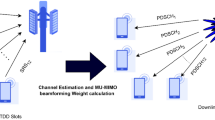Abstract
In this work, a two dimensional (2D) wavelength/time code is developed. The 64 bit 2D code is constructed by a technique based on folding of Golomb rulers referred in this work as modified Golomb code (2D MGC) and the proposed 2D code is generated using Java 8.1 software. The performance of the proposed 2D MGC is evaluated in terms of bit error rate (BER), received signal power, and time domain analysis of multiple users. In this experiment, it is found that the BER increases with multiple numbers of simultaneous users due to multiple access interference. The proposed 2D code yields better network performance in terms of BER compared to that of different existing 2D OCDMA codes. In this work, mathematical analysis is also carried out to prove that the proposed 64 bit code is optimal satisfying auto and cross correlation properties. Furthermore, the complexity analysis of the proposed 64 bit optical code division multiple access (OCDMA) code is analysed. The OCDMA model is validated using the optisystem software.












Similar content being viewed by others
References
Monga, H. (2015). Performance evaluation on optical code division multiple access system. Thesis, Thapper University, Punjab, India.
Hernandez, V. J., Mendez, A. J., Bennett, C. V., & Lennon, W. J. (2005). Simple robust receiver structure for gigabit ethernet O-CDMA using matrix codes. Journal of Lightwave Technology, 23(10), 3105–3110.
Sayed, A., Jolly, L., & Khot, U. P. (2014). Analysis of effect of MAI on an OCDMA system. In IJCA proceedings on international conference and workshop on emerging trends in technology (Vol. 1, pp. 39–44).
Chauhan, R. C. S. (2015). Design of unipolar (optical) orthogonal codes and their maximum clique sets. Thesis, Uttar Pradesh Technical University, Lucknow.
Shivaleela, E. S., Ganesh, S., & Srinivas, T. (2009). All-optical FO-CDMA network: Performance analysis. In ICOP-2009: International conference on optics and photonics, Chandigarh (Vol. 21, No. 11).
Jyoti, V., & Kaler, R. S. (2011). Design and implementation of 2-dimensional wavelength/time codes for OCDMA. Optik: International Journal for Light and Electron Optics, 122, 851–857.
Shivaleela, E. S., Selvarajan, A., & Srinivas, T. (2005). Two-dimensional optical orthogonal codes for fiber-optic CDMA networks. Journal of Lightwave Technology, 23(2), 647–654.
Yang, Y. C.-C., & Huang, J.-F. (2003). Two-dimensional M-matrices coding in spatial/frequency optical CDMA networks. IEEE Photonics Technology Letters, 15, 168–170.
Mendez, A. J., Gagliardi, R. M., Hernandez, V. J., Bennet, C. V., & Lennon, W. J. (2003). Design and performance analysis of wavelength/time (W/T) matrix codes for optical CDMA. IEEE Journal of Lightwave Technology, 21(10), 2524–2533.
Kim, R. M. H., Chen, L. R., & Bajcsy, J. (2002). Design and performance of 2D codes for wavelength-time optical CDMA. IEEE Photonics Technology Letters, 14, 714–716.
Hernandez, V. J., Mendez, A. J., Bennett, C. V., Gagliardi, R. M., & Lennon, W. J. (2005). Bit-error-rate analysis of a 16-user gigabit ethernet optical-CDMA (O-CDMA) technology demonstrator using wavelength/time codes. IEEE Photonics Technology Letters, 17(12), 2784–2786.
Gao, Z., Dai, B., Wang, X., Kataoka, N., & Wada, N. (2011). Transparent transmission of a secure time domain spectral phase encoding/decoding DPSK–OCDM signal over a DWDM network. Journal of Optical Communication Networks, 3(5), 404–410.
Wang, T. C., Chang, C. Y., Yang, G. C., & Kwong, W. C. (2008). A new family of wavelength-time codes for optical CDMA. In IFIP international conference on wireless and optical communications networks (pp. 1–5).
Menon, P. S., Zahid, A. Z. G., Mandeep, J. S., & Shaari, S. (2012). Realization of 2-D OCDMA network using EDW code. Optik: International Journal for Light and Electron Optics, 123, 1385–1389.
Arief, A. R., Aljunid, S. A., Anuar, M. S., Junita, M. N., & Ahmad, R. B. (2013). Cardinality enhancement of spectral/spatial modified double weight code optical code division multi-access system by PIIN suppression. Journal of Optik, 124, 3786–3793.
Nasaruddin, T. T. (2008). Design of strict variable weight optical orthogonal codes for differentiated quality of service in optical CDMA networks. International Journal of Computer Network, 52, 2077–2086.
Gaousuad, C., Morelle, M., Vergonjanne, A. J., Berthelemot, C. A., Cances, J. P., & Dumas, J. M. Optimal code design for multi-wavelength OOC optical CDMA system. https://pdfs.semanticscholar.org/bb27/2a497240caeccb0310e0704fbcf4e749305e.pdf.
Huang, J.-F., Yang, C.-C., & Chiu, I.-M. (2006). Hybrid MQC/M-matrices coding over non-coherent spectral/spatial optical CDMA networks. International Journal of Microwave & Optical Technology, 1(2), 592–595.
Wei, Z., & Ghafouri-Shiraz, H. (2002). Codes for spectral-amplitude-coding optical CDMA systems. Journal of Light wave Technology, 20(8), 1284–1289.
Anuar, M. S., Aljunid, S. A., Saad, N. M., & Hamzah, S. M. (2009). New design of spectral amplitude coding in OCDMA with zero cross correlation. Optics Communication, 282(14), 2659–2664.
Yang, C. C., Huang, J. F., & Tseng, S. P. (2004). Optical CDMA network codes structured with M-sequence codes over waveguide-grating routers. IEEE Photonic Technology Letters, 16(2), 641–643.
Abdulla, A. R. A. J., Aljunid, S. A., Safer, A. M., Nordin, J. M., & Ahmad, R. B. (2012). Mitigation of multiple access interference using two-dimensional modified double weight codes for optical code division multiple access systems. Optical Engineering, 51(6), 065007.
Chang, Y., & Miao, Y. (2003). Constructions for optimal optical orthogonal codes. Discrete Mathematics, 261, 127–139.
Ramaswami, R., Sivarajan, K. N., & Sasaki, G. H. (2010). Optical networks: A practical perspective (3rd ed.). San Francisco: Morgan Kaufmann.
Dutta, C., Pandurangan, G., Rajaraman, R., & Roche, S. (2015). Coalescing-branching random walks on graph. Journal ACM Transaction on Parallel Computing: Special Issue for SPAA 2013, 2(3), 176–185.
Acknowledgements
The author would like to extend their sincere appreciation to the All India Council of Technical Education (AICTE) for the funding of this research through the research Project Number 20/AICTE/RIFD/RPS (POLICY-II) 2/2012-13.
Author information
Authors and Affiliations
Corresponding author
Ethics declarations
Conflict of interest
All authors declare that they have no conflict of interest.
Appendix
Appendix



Rights and permissions
About this article
Cite this article
Singhdeo, S., Bhanja, U. Design and performance analysis of modified two dimensional Golomb code for optical code division multiple access networks. Telecommun Syst 69, 77–94 (2018). https://doi.org/10.1007/s11235-018-0428-2
Published:
Issue Date:
DOI: https://doi.org/10.1007/s11235-018-0428-2




